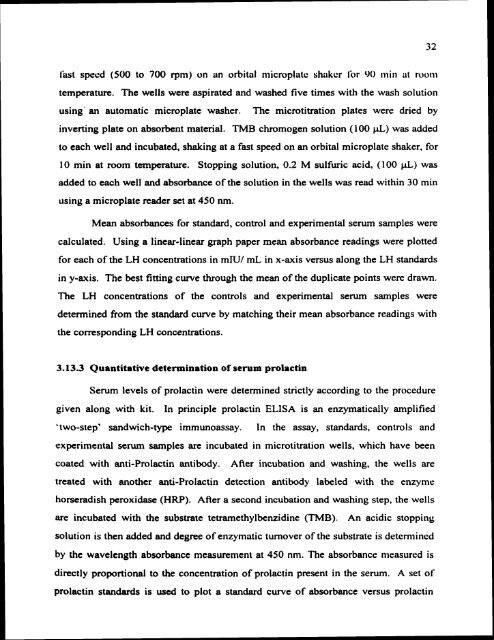ON TESTIS AND EPlDlDYMlS OF RATS - Pondicherry University ...
ON TESTIS AND EPlDlDYMlS OF RATS - Pondicherry University ...
ON TESTIS AND EPlDlDYMlS OF RATS - Pondicherry University ...
Create successful ePaper yourself
Turn your PDF publications into a flip-book with our unique Google optimized e-Paper software.
lust sped (500 to 700 rpm) on an orbital microplate shakcr Ibr LJO min at room<br />
temperature. The wells were aspirated and washed five times with the wash solution<br />
using an automatic microplate washer.<br />
The microtitration plates were dried by<br />
inverting plate on absorbent material. TMB chromogen solution (100 pL) was added<br />
to each well and incubated. shaking at a fast speed on an orbital microplate shaker, for<br />
10 min at room temperature. Stopping solution, 0.2 M sulfuric acid, (100 pL) was<br />
added to each well and absorbance of the solution in the wells was read within 30 min<br />
using a microplate reader set at 450 nm.<br />
Mean absorbances for standard, control and experimental serum samples were<br />
calculated. Using a linear-linear graph paper mean absorbance readings were plotted<br />
for each of the LH concentrations in mIU/ rnL in x-axis versus along the LH standards<br />
in y-axis. The best fitting curve through the mean of the duplicate points were drawn.<br />
The LH concentrations of the controls and experimental serum samples were<br />
determined from the standard curve by matching their mean absorbance readings with<br />
the corresponding LH concentrations.<br />
3.13.3 Quantitative determination of serum prolactin<br />
Serum levels of prolactin were determined strictly according to the procedure<br />
given along with kit. In principle prolactin ELlSA is an enzymatically amplified<br />
'two-step' sandwich-type immunoassay. In the assay, standards, controls and<br />
experimental serum samples are incubated in microtitration wells, which have been<br />
coated with anti-Prolactin antibody. AAer incubation and washing, the wells are<br />
treated with another anti-Prolactin detection antibody labeled with the enzyme<br />
hotseradish peroxide (HRP). After a second incubation and washing step, the wells<br />
are incubated with the substrate tetrarnethylbcnzidine (TMB). An acidic stopping<br />
solution is then added and degree of enzymatic turnover of the substrate is determined<br />
by the wavelength absorbance measurement at 450 nm. The absorbance measured is<br />
directly proportional to the concentration of prolactin present in the serum. A set of<br />
prolactin standards is used to plot a standard curve of absorbance versus prolactin

















